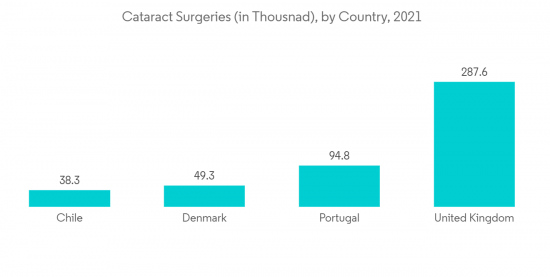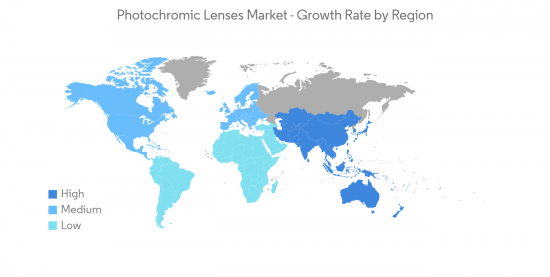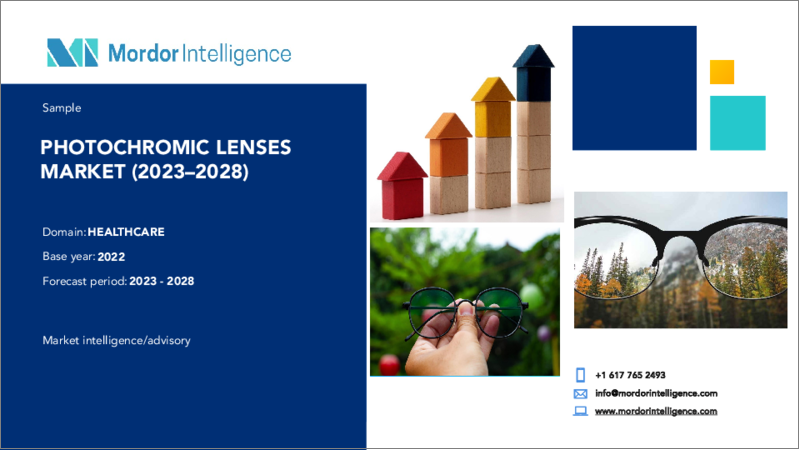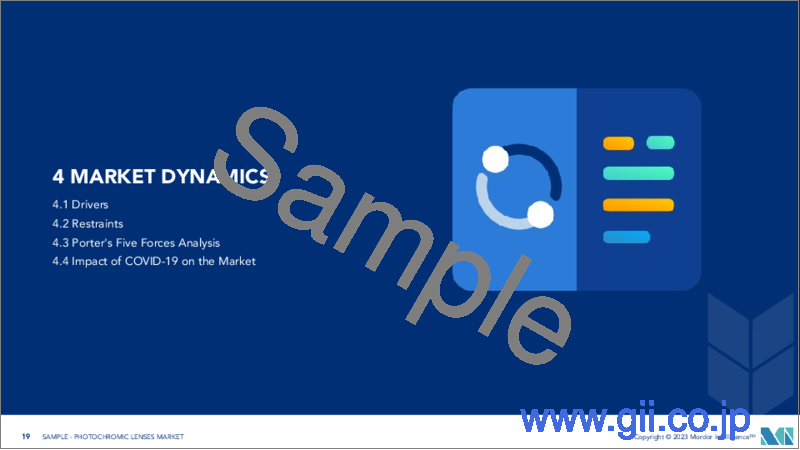|
|
市場調査レポート
商品コード
1333721
フォトクロミックレンズの市場規模・シェア分析- 成長動向と予測(2023年~2028年)Photochromic Lenses Market Size & Share Analysis - Growth Trends & Forecasts (2023 - 2028) |
||||||
|
● お客様のご希望に応じて、既存データの加工や未掲載情報(例:国別セグメント)の追加などの対応が可能です。 詳細はお問い合わせください。 |
|||||||
| フォトクロミックレンズの市場規模・シェア分析- 成長動向と予測(2023年~2028年) |
|
出版日: 2023年08月08日
発行: Mordor Intelligence
ページ情報: 英文 140 Pages
納期: 2~3営業日
|
- 全表示
- 概要
- 目次
フォトクロミックレンズ市場規模は、2023年の68億8,000万米ドルから2028年には91億3,000万米ドルに成長し、予測期間(2023年~2028年)のCAGRは5.81%になると予測されています。
パンデミックの間、世界各国はCOVID-19(コロナウイルス)のかなりの脅威に直面してきました。その他の活動では、いくつかの企業が他国との貿易を停止し、渡航制限などを実施したため、世界中の主要企業の時価総額が減少し、工業生産やその他の事業活動が低下しました。しかし、鎖国によるデジタル学習や仕事の増加により、近視など視力に関する問題が発生したとの指摘も増えています。また、パンデミック後にほとんどの国が渡航制限を撤廃し、需給面から軌道に乗りつつあることも、今後数年間の市場成長の要因の一つです。
市場成長の重要な要因は、フォトクロミックレンズの採用が拡大していることであり、高齢者層におけるフォトクロミックレンズの需要の増加がフォトクロミックレンズ市場を牽引すると予想されます。例えば、日本は世界で最も急速に高齢化が進んでいる国です。World Ageing 2019」レポートによると、2019年の日本の65歳以上人口は3,552万4,000人(28%)で、2030年には3,727万8,000人(30.9%)に達すると予測されています。今後、眼に関連した障害を起こしやすい老年人口が増加することが予想され、それが最終的に市場の成長を促進することが期待されます。
世界中の目の健康を改善するための政府や民間団体によるイニシアチブは、今後数年間でフォトクロミックレンズ市場を加速させると予測されています。2021年5月に世界保健機関(WHO)が発表したデータによると、世界中で8億人以上の人々が遠視や近視などの遠方視力障害を抱えており、適切なメガネを使用することで治療が可能です。したがって、複数の組織や市場関係者による認知度の向上により、治療へのアクセスが改善されれば、市場の成長が促進される可能性があります。
技術の進歩、小売店の増加、快適性とスタイルの向上などの追加要因が、予測期間中にフォトクロミックレンズ市場を牽引すると思われます。眼病患者の増加、眼科診断手順の増加、個人の意識の高まりがフォトクロミックレンズ市場の成長に好影響を与えそうです。
フォトクロミックレンズ市場動向
予測期間中、矯正用レンズが大きな市場シェアを占める見込み
矯正フォトクロミックレンズは、処方フォトクロミックレンズとしても知られ、処方眼鏡の利点とフォトクロミックレンズの光適応特性を組み合わせたものです。これらのレンズは、近視、遠視、乱視、老眼などの屈折異常を矯正するように設計されており、紫外線に反応して自動的に色合いを調整するという利点もあります。眼に関連する疾患の増加や主要な市場参入企業による取り組みなどの要因が、予測期間中に調査された市場の成長を増加させると予想されます。
調査した市場の成長に寄与する主な要因には、眼関連障害の発生率と有病率の増加が含まれます。例えば、世界保健機関(WHO)の2021年10月の報告書によると、世界中で約22億人が近見または遠見の視力障害を抱えており、そのうち約10億件の視力障害は予防できる、または予防できた可能性があります。世界中の視力障害患者の負担の大きさと治療の可能性は、レンズの需要の高さを示しており、予測期間中に調査された市場の成長にプラスの影響を与えると予想されます。同様に、視力損失専門家グループ(VEEG)は2021年に、世界全体で11億人が視力損失を抱えて生活しており、その90%が中低所得国(LMICs)に住んでいると報告しています。
企業による協定などの取り組みは、市場に新しく革新的な製品を加えることにつながるため、成長を助ける重要な要因の1つです。例えば、2022年3月、EssilorLuxotticaはCooperCompaniesとSightGlass Visionの合弁契約を締結しました。SightGlass Visionの拡散光学技術は、何千ものマイクロドットをレンズに組み込むことで光を柔らかく散乱させ、子供の近視の成長を最小限に抑えます。これにより、近視管理カテゴリーを拡大する新しいメガネレンズ技術の商品化が加速します。
製品の発売は、調査した市場の成長を助けるもう一つの要因です。例えば、2023年4月、HOYAビジョンケアはMiYOSMARTサンシリーズを発売しました。フォトクロミックメガネレンズ「MiYOSMART Chameleon」と偏光メガネレンズ「MiYOSMART Sunbird」は、近視の屈折異常を矯正し近視の進行を遅らせると同時に、強い日差しからの保護を提供します。
このように、フォトクロミックレンズの利点を強調する眼に関連する疾患の増加や、市場関係者による取り組みが、調査された市場の成長を増加させると予想されます。

予測期間中、北米が大きな市場シェアを占める見込み
北米地域は、高水準のヘルスケアインフラとフォトクロミックレンズの需要増加により、大きな市場シェアを占めると予想されます。
糖尿病網膜症(DR)は、糖尿病患者の間で懸念される主な原因の1つであり、多くの場合、目のかすみ、目の痛み、突然の視力低下を引き起こします。そのため、ほとんどの人がより良い視力を得るために予防矯正用フォトクロミックレンズを使用しています。この地域でDRに対する懸念が高まるにつれ、フォトクロミックレンズの需要が増加し、調査された市場の成長を牽引しています。例えば、Jobson Healthcare Information LLCが2022年6月に発表したデータによると、糖尿病は現役世代の成人における失明の主な原因の1つです。米国の糖尿病成人の11.7%近くが失明を含む視力障害を持っており、糖尿病患者の約半数が2030年までにDRを発症すると予測されています。
また、2022年8月にEyenuk Inc.が発表したプレスリリースによると、DRは糖尿病性眼疾患の中でも最も一般的な疾患の一つです。カナダでは、2021年に75万人がDRに罹患し、DRがカナダのヘルスケアシステムに与える経済的影響は年間12億米ドルでした。この高い糖尿病有病率は、フォトクロミックレンズの採用を増加させ、分析期間中に調査した市場の成長を促進すると予想されます。
さらに、同地域における主要な市場参入企業による製品承認や発売の増加も、成長を後押しすると予測される要因の一つです。例えば、2021年2月、米国とカナダでEssilorLuxottica社からRay-Ban Authentic製品ラインが発売されました。この製品ラインは、フォトクロミックレンズとブルーライトフィルターによる移行技術を特徴としています。
そのため、対象人口における様々な眼疾患の有病率の上昇や企業活動などの要因により、フォトクロミックレンズ市場はこの地域で大きな成長を遂げると予測されています。

フォトクロミックレンズ産業の概要
フォトクロミックレンズ市場は、地域レベルおよび世界レベルで事業を展開する少数の市場プレイヤーの存在により、やや統合された性質を持っています。一部の有力プレーヤーは、世界の市場ポジションを強化するために、他社との買収や新製品のリリースを精力的に行っています。主なプレーヤーとしては、Corning Incorporated、EssilorLuxottica SA、Carl Zeiss AG、Hoya Corporation、Vision Dynamics LLCなどが挙げられます。
その他の特典:
- エクセル形式の市場予測(ME)シート
- 3ヶ月間のアナリストサポート
目次
第1章 イントロダクション
- 調査の前提条件と市場定義
- 調査範囲
第2章 調査手法
第3章 エグゼクティブサマリー
第4章 市場力学
- 市場概要
- 市場促進要因
- フォトクロミックレンズの採用拡大
- OTC製品の幅広い入手可能性
- 市場抑制要因
- 偽造品の存在
- ポーターのファイブフォース分析
- 新規参入業者の脅威
- 買い手・消費者の交渉力
- 供給企業の交渉力
- 代替品の脅威
- 競争企業間の敵対関係の強さ
第5章 市場セグメンテーション(金額ベース、市場規模- 100万米ドル)
- 素材別
- ガラス
- ポリカーボネート
- プラスチック
- 技術別
- 紫外線と可視光線
- インビビングとトランスボンディング
- 質量
- その他の技術
- 用途別
- 矯正
- 予防
- 販売チャネル別
- 専門クリニック
- オンライン
- その他の販売チャネル
- 地域別
- 北米
- 米国
- カナダ
- メキシコ
- 欧州
- ドイツ
- 英国
- フランス
- イタリア
- スペイン
- その他欧州
- アジア太平洋
- 中国
- 日本
- インド
- オーストラリア
- 韓国
- その他アジア太平洋地域
- 中東・アフリカ
- GCC
- 南アフリカ
- その他中東とアフリカ
- 南米
- ブラジル
- アルゼンチン
- その他南米
- 北米
第6章 競合情勢
- 企業プロファイル
- Corning Incorporated
- EssilorLuxottica SA
- Apax Fund(Rodenstock GmbH)
- Carl Zeiss AG
- Hoya Corporation
- Vision Dynamics LLC
- Tokai Optical Co. Ltd
- Sundex Optical Co. Ltd
- Jiangsu Aogang Optical Glasses Co. Ltd
- GKB Ophthalmic Limited
第7章 市場機会と今後の動向
The Photochromic Lenses Market size is expected to grow from USD 6.88 billion in 2023 to USD 9.13 billion by 2028, at a CAGR of 5.81% during the forecast period (2023-2028).
During the pandemic, countries across the world have been facing a considerable threat of COVID-19 (coronavirus). Several companies had suspended trade with other countries, implemented travel restrictions, etc., thus, leading to a decline in market capitalizations of major companies across the world, along with a decline in industrial production and other business activities. However, there has been increasing evidence of the development of vision-related problems, such as myopia, due to the increased adoption of digital learning and work due to the lockdown. Also, the removal of travel restrictions by most countries after the pandemic and getting back on track from the supply and demand sides are some of the factors responsible for the growth of the market in the coming years.
The significant factors attributing to the market's growth are the growing adoption of the photochromic lens and the increasing demand for photochromic lenses among the elderly population is expected to drive the photochromic lens market. For instance, Japan has the world's fastest aging population. According to the World Ageing 2019 report, the population above 65 years of age in Japan was 35.524 million (28%) in 2019, which is projected to reach 37.278 million (30.9%) in 2030. The geriatric population is expected to increase in coming years who are more prone to eye-related disorders, which is expected to ultimately drive the growth of the market.
Initiatives by the govenrment and private oragnizations to improve eye health across the world is projected to accelrate the photochromic lenses market in coming years. According to the data published by the World Health Organization in May 2021, greater than 800 million people across the world have distance impairment such as hypermetropia and myopia or near vision impairment that can be treat with an suitable pair of spectacles. Hence, improving access to treatment by increasing awarness by several organizations and marke players may propel the market growth.
Additional factors such as the advancements in technology, growing retail outlets, and gains in comfort and style are likely to drive the market for photochromic lenses during the forecast period. The continued growth of the increased cases of eye disease, increasing ophthalmology diagnostic procedures, and growing awareness among individuals are likely to have a positive impact on the growth of the photochromic lens market.
Photochromic Lenses Market Trends
Corrective Lens Expected to Hold a Significant Market Share over the Forecast Period
Corrective photochromic lenses, also known as prescription photochromic lenses, combine the benefits of prescription eyeglasses with the light-adaptive properties of photochromic lenses. These lenses are designed to correct refractive errors such as nearsightedness (myopia), farsightedness (hyperopia), astigmatism, or presbyopia while providing the added benefit of automatic tint adjustment in response to UV light. Factors such as the increasing incidences of eye-related disorders and initiatives by key market players are expected to increase the growth of the market studied over the forecast period.
The major factors that contribute to the growth of the market studied include the increasing incidence and prevalence of eye-related disorders. For instance, according to the October 2021 report of the World Health Organization, about 2.2 billion people across the world have near or distant vision impairment, of which approximately 1 billion cases of vision impairment can be prevented or could have been prevented. The high burden of cases of vision impairment around the world and the possibility of treatment indicate a high demand for lenses, which is expected to have a positive impact on the growth of the market studied during the forecast period. Similarly, the Vision Loss Expert Group (VEEG), in 2021, reported that globally, 1.1 billion people live with vision loss, and 90% of such people live in low- and middle-income countries (LMICs).
Initiatives such as agreements by companies are one of the key factors that aid growth as it leads to the addition of new and innovative products in the market. For instance, in March 2022, EssilorLuxottica signed a joint venture agreement with CooperCompanies for SightGlass Vision. SightGlass Vision's Diffusion Optics Technology softly scatters light by incorporating thousands of micro-dots into the lens to minimize the growth of myopia in children. This accelerates the commercialization of novel spectacle lens technologies to expand the myopia management category.
Product launches are another factor that aid in the growth of the market studied. For instance, in April 2023, HOYA Vision Care launched the MiYOSMART sun range. The photochromic spectacle lenses, MiYOSMART Chameleon, and polarised spectacle lenses, MiYOSMART Sunbird, provide protection from intense sunlight while correcting the myopic refractive error and slowing myopia progression.
Thus, the increasing incidences of eye-related disorders that highlight the advantages of photochromic lenses and initiatives by market players are expected to increase the growth of the market studied.

North America is Expected to Hold a Significant Market Share Over the Forecast Period
The North American region is expected to hold a significant market share due to the high standards of healthcare infrastructure and the rising demand for photochromic lenses.
Diabetic Retinopathy (DR) is one of the major causes of concern among people with diabetes, which most often causes blurred vision, eye pain, and sudden vision loss. Hence, most people use preventive and corrective photochromic lenses for better vision. With rising concerns about DR in the region, the demand for photochromic lenses is increasing and driving the growth of the market studied. For instance, according to data released by Jobson Healthcare Information LLC in June 2022, diabetes is one of the major causes of blindness in working-age adults. Nearly 11.7% of adults in the United States with diabetes have a vision disability, including blindness, and approximately half of the patients with diabetes are predicted to develop DR by 2030.
In addition, according to a press release published by Eyenuk Inc. in August 2022, DR is one of the most common forms of diabetic eye disease. In Canada, 750,000 people had DR in 2021, and the economic impact of DR on the Canadian healthcare system was USD 1.2 billion annually. This high prevalence of DR is expected to increase the adoption of photochromic lenses and fuel the growth of the market studied over the analysis period.
Furthermore, the increasing number of product approvals, as well as launches by the key market players in the region, is another factor that is predicted to boost growth. For instance, in February 2021, the Ray-Ban Authentic product line was launched by EssilorLuxottica in the United States and Canada. The product line features transition technology with photochromic lenses and blue light filtering.
Therefore, owing to the factors such as the rising prevalence of various eye disorders among the target population and company activities, the photochromic lenses market is anticipated to witness significant growth in the region.

Photochromic Lenses Industry Overview
The photochromic lens market is slightly consolidated in nature due to the presence of a few market players operating regionally and at the global level. Some prominent players are vigorously making acquisitions and releasing new products with other companies to consolidate their market positions globally. Some key players are Corning Incorporated, EssilorLuxottica SA, Carl Zeiss AG, Hoya Corporation, and Vision Dynamics LLC.
Additional Benefits:
- The market estimate (ME) sheet in Excel format
- 3 months of analyst support
TABLE OF CONTENTS
1 INTRODUCTION
- 1.1 Study Assumptions and Market Definition
- 1.2 Scope of the Study
2 RESEARCH METHODOLOGY
3 EXECUTIVE SUMMARY
4 MARKET DYNAMICS
- 4.1 Market Overview
- 4.2 Market Drivers
- 4.2.1 Growing Adoption of Photochromic Lens
- 4.2.2 Wide Range Availability of OTC Products
- 4.3 Market Restraints
- 4.3.1 Presence of Counterfeit Products
- 4.4 Porter's Five Forces Analysis
- 4.4.1 Threat of New Entrants
- 4.4.2 Bargaining Power of Buyers/Consumers
- 4.4.3 Bargaining Power of Suppliers
- 4.4.4 Threat of Substitute Products
- 4.4.5 Intensity of Competitive Rivalry
5 MARKET SEGMENTATION (Market Size by Value - USD million)
- 5.1 By Material
- 5.1.1 Glass
- 5.1.2 Polycarbonate
- 5.1.3 Plastic
- 5.2 By Technology
- 5.2.1 UV and Visible Light
- 5.2.2 Imbibing and Trans-bonding
- 5.2.3 In Mass
- 5.2.4 Other Technologies
- 5.3 By Application
- 5.3.1 Corrective
- 5.3.2 Preventive
- 5.4 By Sales Channel
- 5.4.1 Specialty Clinics
- 5.4.2 Online
- 5.4.3 Other Sales Channel
- 5.5 By Geography
- 5.5.1 North America
- 5.5.1.1 United States
- 5.5.1.2 Canada
- 5.5.1.3 Mexico
- 5.5.2 Europe
- 5.5.2.1 Germany
- 5.5.2.2 United Kingdom
- 5.5.2.3 France
- 5.5.2.4 Italy
- 5.5.2.5 Spain
- 5.5.2.6 Rest of Europe
- 5.5.3 Asia-Pacific
- 5.5.3.1 China
- 5.5.3.2 Japan
- 5.5.3.3 India
- 5.5.3.4 Australia
- 5.5.3.5 South Korea
- 5.5.3.6 Rest of Asia-Pacific
- 5.5.4 Middle East and Africa
- 5.5.4.1 GCC
- 5.5.4.2 South Africa
- 5.5.4.3 Rest of Middle East and Africa
- 5.5.5 South America
- 5.5.5.1 Brazil
- 5.5.5.2 Argentina
- 5.5.5.3 Rest of South America
- 5.5.1 North America
6 COMPETITIVE LANDSCAPE
- 6.1 Company Profiles
- 6.1.1 Corning Incorporated
- 6.1.2 EssilorLuxottica SA
- 6.1.3 Apax Fund (Rodenstock GmbH)
- 6.1.4 Carl Zeiss AG
- 6.1.5 Hoya Corporation
- 6.1.6 Vision Dynamics LLC
- 6.1.7 Tokai Optical Co. Ltd
- 6.1.8 Sundex Optical Co. Ltd
- 6.1.9 Jiangsu Aogang Optical Glasses Co. Ltd
- 6.1.10 GKB Ophthalmic Limited




